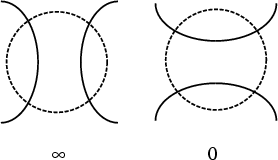|
|
|

A region in a Knot or Link projection plane surrounded by a Circle such that the Knot or Link crosses the circle exactly four times. Two tangles are equivalent if a sequence of Reidemeister Moves can be used to transform one into the other while keeping the four string endpoints fixed and not allowing strings to pass outside the Circle.
The simplest tangles are the ![]() -tangle and 0-tangle, shown above. A tangle with
-tangle and 0-tangle, shown above. A tangle with ![]() left-handed twists is called an
left-handed twists is called an
![]() -tangle, and one with
-tangle, and one with ![]() right-handed twists is called a
right-handed twists is called a ![]() -tangle. By placing tangles side by side, more
complicated tangles can be built up such as (
-tangle. By placing tangles side by side, more
complicated tangles can be built up such as (![]() , 3, 2), etc. The link created by connecting the ends of the tangles is
now described by the sequence of tangle symbols, known as Conway's Knot Notation. If tangles are multiplied by 0
and then added, the resulting tangle symbols are separated by commas. Additional symbols which are used are the period,
colon, and asterisk.
, 3, 2), etc. The link created by connecting the ends of the tangles is
now described by the sequence of tangle symbols, known as Conway's Knot Notation. If tangles are multiplied by 0
and then added, the resulting tangle symbols are separated by commas. Additional symbols which are used are the period,
colon, and asterisk.
Amazingly enough, two tangles described in this Notation are equivalent Iff the Continued Fractions of the form

See also Algebraic Link, Flype, Pretzel Knot
References
Adams, C. C. The Knot Book: An Elementary Introduction to the Mathematical Theory of Knots.
New York: W. H. Freeman pp. 41-51, 1994.
Burde, G. and Zieschang, H. Knots. Berlin: de Gruyter, 1985.